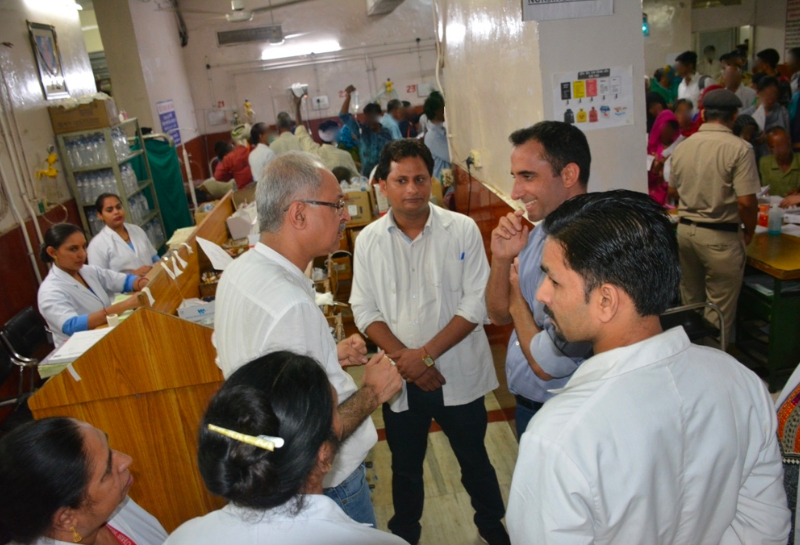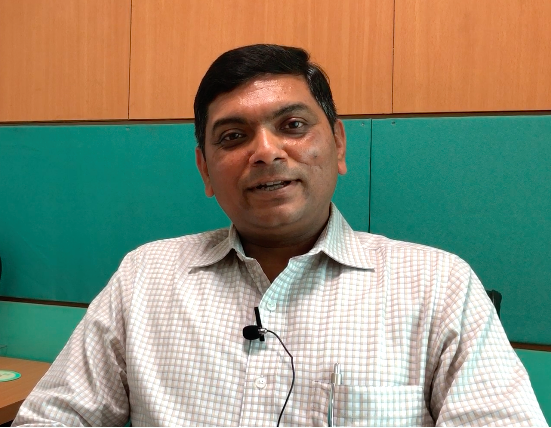Having just returned from my trip to see India's health system I was telling a friend about everything I'd seen and learnt. They commented "sounds interesting but surely there isn't much you can bring back for the NHS to learn from India?". Despite the challenges in Indian healthcare, there are a number of lessons we can share.
Visiting Haryana's 2,000 bedded state hospital
After visiting a high-end private hospital in Delhi (see previous blog) I went to the main hospital of Haryana State in Rohtak. The Post-graduate Institute of Medical Sciences (PGIMS for short) is about two hours north west of Delhi, has over 2,000 beds and a budget of £69 million. It's currently rated the second best medical school in India. Last year it saw:
- 2,200,000 outpatient appointments
- 110,000 admissions
- 234,768 operations
A seriously sized hospital system I think we'd all agree! During my time at PGIMS the team there led by Vice Chancellor Professor Kalra were enormously welcoming and went out of their way to showcase the hospital from its new 3T MRI unit and recently built trauma centre, to its stretched ED and wards. There were three points that hit me about the hospital and its similarities and differences to the NHS.

Meeting clinical teams in the new Trauma Centre at PGIMS
1. Passion and dedication
A point of similarity with the NHS was the passion and dedication of the staff at PGIMS. Staff across the hospital talked passionately of their commitment to delivering the best care and doing public good. New consultants working in the state sector in India earn around half what they could earn privately. When I asked them why they choose to work for state hospitals, consultants such as Dr Parveen Malhotra, Head of Gastroenterology (pictured below) said:
"In the private sector you can earn the amount you want, but in the government sector... it is the satisfaction that you are working for humanity"

Dr Malhotra in his endoscopy suite
Whilst training, Dr Malhotra had seen many patients dying due to GI bleeds. This was his motivation to train in gastroenterology and work for the state hospital establishing a GI bleed service amongst many others including Hepatitis B and C services. The Hepatitis C programme he has created has now treated more than 10,000 patients in Haryana and the scheme is being rolled out nationally. He established the endoscopy unit in 2010 and since then has completed 30,000 endoscopies through the one room.
Generally amongst the staff I spoke to there was a feeling of optimism and empowerment to make changes. Many of them saw teaching and training the next generation of clinicians as a key motivator and reason for working in the state sector. I pushed for areas people felt needed to be improved: funding levels and the need to train more doctors were highlighted. But there was hardly any criticism of either administrators or the government - I got the impression that teams felt empowered to develop services as they liked within the resource constraints they faced.
2. Achieving a lot with little funds
One factor I was struck by was the volume of patients seen by departments with relatively little resource. Just as a few examples:
- Clinics often see about 200 patients per consultant team (including registrar and juniors) in a half day
- The ED saw an average of 850 attendances a day with three consultants, two SHOs and trainees. During monsoon attendances can reach 1,300
Clearly I'm not saying we should replicate these figures in the UK! There is an evident and well-publicised need to increase medical staff and capacity in the state sector in India. But what was amazing was the resilience of staff seeing so many patients, the innovation employed to manage very high demand, and the explicit need to prioritise resources to those that are most ill or most able to benefit from treatment.

Discussing ED pressures with Clinical Director Dr Dhruva Chaudhary
Given the level of demand I expected waiting times to be very high but was surprised when in both outpatients and endoscopy I was told there were no waiting times. For example, if a patient attended a gastro clinic at PGIMS they would be seen the same day. If the consultant felt they needed an OGD, they would receive it that afternoon. When I asked one of the medical consultants in outpatients why they didn't ask people to wait to reduce clinic volumes he replied:
"People just wouldn't accept it, some of them have walked a long way from their villages and wouldn't leave until they get seen."
For the equivalent of 50p patients who make the journey to PGIMS can see a consultant or member of their team and receive an endoscopy if needed on the day they arrive. There are very real challenges: if you're admitted you may have to share a bed in an open ward at times of high demand, and clearly crowding both in outpatients and ED are an issue. But I was surprised how quickly people could see a specialist.
3. Social support
A big contrast between the Indian healthcare system and the UK is the social and family support networks for older people. This shows itself in two main ways: the type of patients being admitted, and the lack of delayed discharge issues faced.
When I visited EDs in both Delhi and Haryana I explained the demographics and conditions typically presenting in EDs in the UK. I explained that falls, confusion and UTIs in older patients are all key factors in growing demand. This is clearly not the pattern in India where ED attendances are more dominantly focussed on seasonal diseases like typhoid and dengue and traumatic injury. I discussed why older patients aren't admitted so much in India with Dr Sandeep Jain, ED consultant and Director of Emergency Medicine at Max Saket (pictured below). His view was that these patients weren't admitted:
"Because of the social fabric we have in India. The family structure is more robust, people take care of their parents [in their homes]"
Similarly there are less issues with delayed discharges as families have people at home to care for relatives when they're ready to go - Dr Jain again:
"Once a patient is stable medically, they can be sent home and their near and dear ones will take care of them"

Dr Sandeep Jain
This isn't something that's easy to replicate in the UK but made me reflect on how we care for and support our elders in their later years. There's much we can learn from cultures such as India in terms of reduced isolation and increased support for older relatives. If you haven't read it, Being Mortal by Atul Gawande is a must-read (buy it now, honestly) on how we need to rethink caring for people at the end of their lives and what we can learn from other cultures especially India.

Reflections for the UK
India's health system has well documented funding challenges and under-provision particularly in rural areas. However, the commitment, passion and range of services at PGIMS really surprised me despite the crowding and high demand. One doctor I spoke to remarked that the NHS system is seen as "the best in the world" but there's still lessons we should take from India:
- the ethos of public service that we share and the ability to remain positive in times of challenge
- the need to innovate in the face of increasing demand and limited resources
- the need to enhance our support for older people so hospital isn't a substitute for reduced and fragmented family networks



/Passle/5a5c5fb12a1ea2042466f05f/MediaLibrary/Images/6168334917af5b10f4bf1d30/2022-04-14-15-27-52-040-62583d78f636e9115805b2d5.png)
/Passle/5a5c5fb12a1ea2042466f05f/MediaLibrary/Images/6168334917af5b10f4bf1d30/2022-08-05-09-59-36-465-62ecea08f636e906acfed639.jpg)
/Passle/5a5c5fb12a1ea2042466f05f/MediaLibrary/Images/6168334917af5b10f4bf1d30/2022-07-28-14-57-17-405-62e2a3cdf636e9180c9835cb.png)
/Passle/5a5c5fb12a1ea2042466f05f/MediaLibrary/Images/6168334917af5b10f4bf1d30/2022-07-20-10-16-56-533-62d7d618f636ea07987f6668.png)
/Passle/5a5c5fb12a1ea2042466f05f/MediaLibrary/Images/6168334917af5b10f4bf1d30/2022-07-15-09-55-32-858-62d13994f636ea1398e71aa9.jpg)